Wool is a highly sought-after material for a plethora of different reasons used in a variety of industries. This is just one reason why proper handling, storing, and marketing of wool fleeces is so important. It’s just as important for wool producers to know what to do with sheep wool after shearing. That will preserve the quality of your wool for you to sell a better product and gain more trust from your customers.
In this article, we’ll go over how to correctly handle, store, and market your wool fleeces after sheep shearing to ensure you fully retain their quality and value for the market. We’ll also cover wool grading, classification, and how to produce a greater amount of wool per sheep.
How is Wool Graded and Classified?
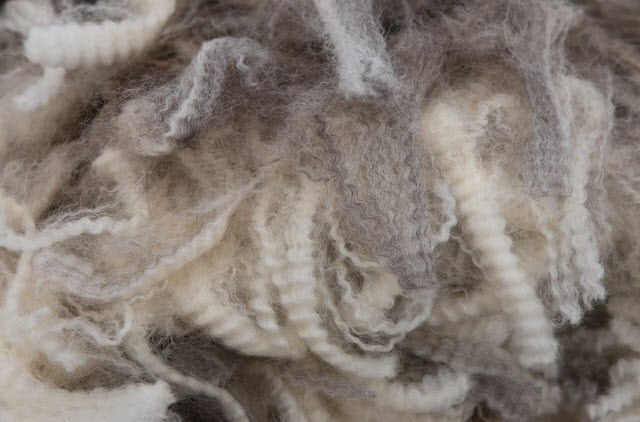
In general, wool sales are done by the pound based on the characteristics of:
- Quality, or how free the wool is from foreign material and the type of character or “life” it has
- Class, or how long the fiber or staple is
- Grade, or the fineness of the wool as a fiber
These designations determine which market and price-point the wool will enter once it goes on sale.
Other factors can improve the marketability of the wool you produce on your farm. These include things like the coloration of the fleece (hand spinners and fiber artists looking for natural colored fibers may seek out rare and unique coloration).
And if someone has a special project and want great consistency, they may look for a single large fleece from one sheep for a special sweater or other garment they are creating.
Improving Your Wool Crop’s Value and Quality
It’s essential that you don’t let your fleeces get contaminated by substances like vegetable matter. This means, not getting feed, grain, or wood from getting onto your sheep.
Maintaining Clean Fleeces
Tips for keeping your sheep’s wool clean are:
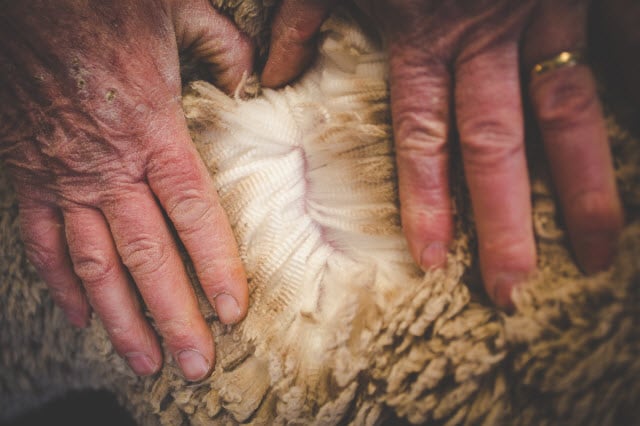
- Use special feeders to ensure chaff and hay doesn’t get on the sheep’s backs.
- Avoid throwing or carrying hay over the sheep when bringing it to the feeders.
- Don’t hold grain over the sheep as you pour grain into the troughs.
- Make sure that wood particles never get onto the sheep since wood particles can’t be removed by a processer.
How to Increase Your Yield of Wool Per Sheep
Below are some things you can do to increase the yield of wool from each sheep:
- Control the presence of external parasites in order to prevent the itching and rubbing that can degrade the quality of the wool. This kind of control is also essential for your sheep’s overall health.
- Take steps for the prevention and control of internal parasites in order to let sheep fully benefit from their food.
- Make sure your feeding program is well-balanced. The quality and amount of food you give to your sheep directly impacts their wool, both in terms of quality and quantity.
- Be aware that certain breeds (such as the Lincoln and Lincoln Cross) may be sheared biannually.
- Keep up the health of your flock. Sheep that are sick or have fevers will end up having weak spots in their wool.
How to Properly Handle Wool
There are many good practices for handling sheep wool before and after shearing to keep it clean and of good quality.
Let’s go over some tips to keep in mind for correctly handling wool:
Shear Under Good Conditions
Do your shearing as early each spring, as the weather allows, and account for when shearers are available.
If it’s possible (in other words, if there are the necessary housing facilities and weather is appropriate), think about shearing prior to lambing. This will mean that you will be able to keep more animals in a specific space and lambing will be easier to observe.
This will also help to avoid wool loss and reduce the risk of staining the wool.
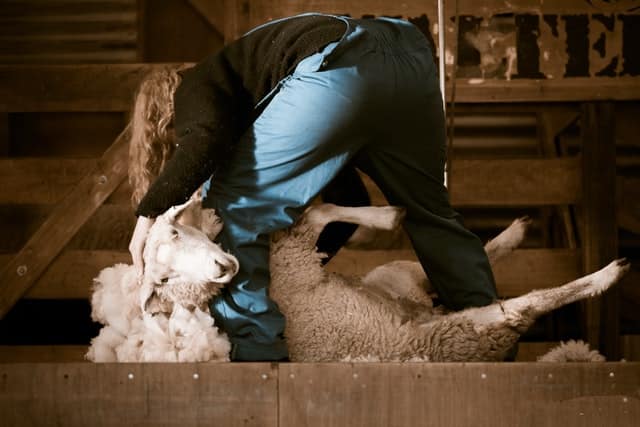
Shearing must be done on a clean and dry surface . If you want a surface that gives better comfort to the shearer and is easier to get clean, consider wooden shearing floor that is 8-foot by 8-foot in area. You can make this surface with:
- Two plywood sheets that are half-inch thick and 4-foot by 8-foot in size
- A frame comprised of 2X4s or 2X3s.
Other surfaces that you could use are a clean canvas atop a clean concrete floor or an old carpet.
Shearing Tips
- Sheep must be dry before shearing takes place. This is the case both close to the skin and on the surface. If wool is at all damp, it will spoil and grow mold.
- After each animal is sheared, properly sweep the area. This will help stop dirt, chaff, or other kinds of material getting onto the wool.
- The fleece from the belly and tags must be kept apart from that of the rest of the animal. This separation needs to be done as the shearing takes place.
- Before shearing takes place, stop the sheep from feeding for several hours. If the sheep have recently eaten, it will probably experience discomfort.
- It is dangerous to try to shear pregnant sheep that may go through lambing soon.
- It’s important for the fleece to be kept in a single piece as the shearing takes place.
I also recommend considering whether you want your flock shorn with electric sheep clippers, or with traditional hand shears. There are pros and cons of each approach, but most farmers today choose the electric route for speed and efficiency.
Handling Sheep Wool After Shearing
As the producer, you must be skilled in how to correctly skirt the fleece, as well as roll and tie it.
Proper skirting of the fleece includes getting rid of dirty mature tags, as well as the dock wool. This will prevent contamination of other fleece in storage from manure and urine stains. It will ensure clean-smelling fleece, too.
Make sure all sweat locks are eliminated. You can spot these by their greasy or black appearance. They are generally found around the sort of “armpit” areas of the sheep. If you’re dealing with light-colored fleece, these will be easy to spot. It will be a bit more labor-intensive to do so in darker fleeces, but it’s still necessary.
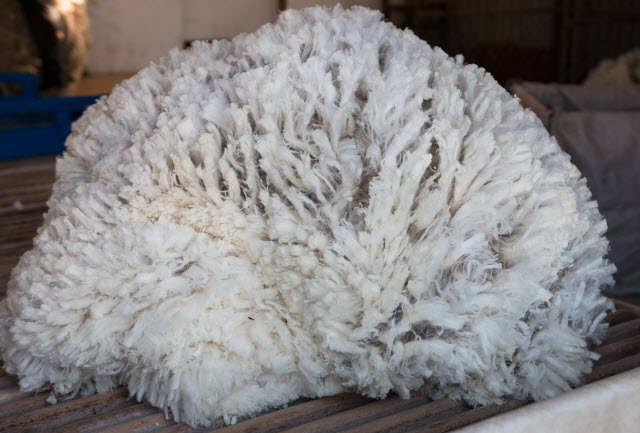
Other Wool Storage Tips
- You must store all your wool in a clean and dry place until it is sent to market. Proper packing and an appropriate storage space will protect the wool, which is vulnerable to moisture and is a perishable good.
- Regulation wool bags must be used for the packing of both loose and tied fleeces. You can buy these bags from sources such as supply houses, wool pool managers, and wool buyers.
- Use paper twine to tie individual fleeces.
- Plan for the separate handling and bagging of belly and tag wools, as well as seedy, burry, off-color, stained, cotted, and dead wools.
It’s crucial that the storage space be monitored for humidity. Fluctuations in the relative level of humidity and condensation can severely damage the fleece. Dryness of the area is essential. Too much humidity and moisture will easily lead to mold and other kinds of damage and mustiness, dramatically decreasing the market value of your wool.
Marketing to Weavers and Spinners
Handcrafted products made of wool are increasingly popular in some parts of the Unites States. Weavers and spinners tend to prefer or even demand a certain kind of wool, like long-fiber fleece wools, clean back wools, or other types of colored wool they’re able to blend with regular white wools. This helps them achieve different natural colors of yarn.
Weavers and spinners are a very promising market for wool producers. These artisans are willing to pay a premium price for the types of wool they desire.
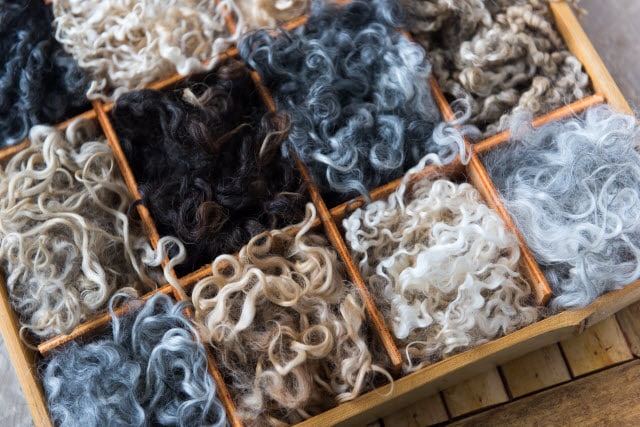
When creating your marketing plan, communicate the quality of your wool and its usefulness to weavers and spinners to target that market.
Correct Handling and Storage of Your Wool is Essential
The only way your wool marketing will be effective is if you’re offering high-quality wool.
Correct handling and storage are crucial for you to reach this point. Jumping into this agricultural sector without having all the knowledge and being ready with the necessary materials is likely to lead to significant financial loss.

